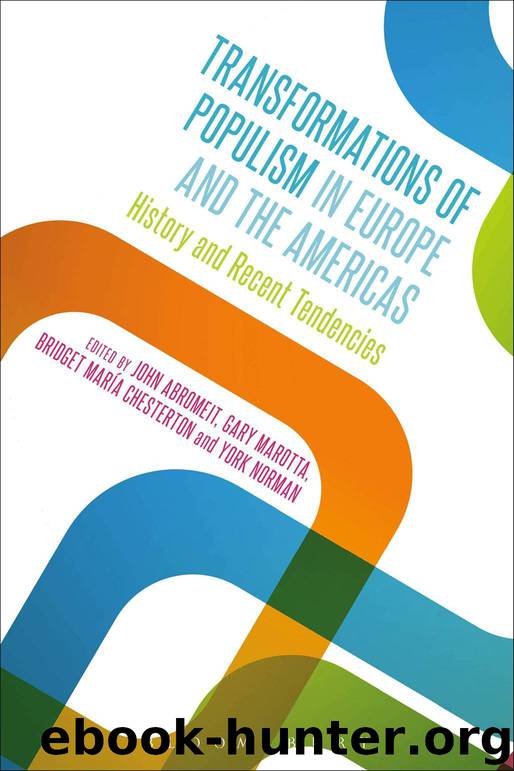Transformations of Populism in Europe and the Americas: History and Recent Tendencies by John Abromeit Bridget María Chesterton Gary Marotta and York Norman

Author:John Abromeit, Bridget María Chesterton, Gary Marotta, and York Norman
Language: eng
Format: azw3
ISBN: 9781474225236
Publisher: Bloomsbury Publishing
Published: 2015-11-19T05:00:00+00:00
In the wake of the [labor] uprisings, the kinds of substantive state commitments that organized workers had gained in populist pacts in the Spanish American republics and the United States over preceding decades finally made it onto the negotiating table in the British Caribbean: housing and education, the rights to organize and strike [and] a mediating role for the state between labor and capital.111
Ernesto Laclau points out that populism is not an ideology itself but arises “at the point where popular-democratic elements are presented as an antagonistic option against the ideology of the dominant bloc.”112 While the individual leaders discussed above do not cleave to a common ideology, they were fully aware of the potency of a rhetorical opposition between the dominant and the oppressed. Also, though they shared the pressures of the Depression, they worked within, and were products of, the parameters of their society. In this way, their politics resembled the notion of populism elaborated by John D. French, who describes its “mirror-like quality” and argues that it “is a movement that maneuvers within but does not direct [the] contradictions” of society at large.113
Conceiving of a populist leader’s approach as a mirroring of society and its contradictions allows for the give and take that occurs in the development of a movement. It also strikes a balance between simplistic explanations of leadership that rely completely on the notion of charisma or that deny a leader’s agency through reference to the spirit of the time that “produces” leaders. This latter perspective characterized Norman Manley’s assessment of Bustamante. “Great occasions of trouble in the history of a people demand and create leaders,” Manley said, and Bustamante was “thrown up” by the people in the crisis of the 1930s.114 In many ways, “great occasions of trouble” also produce new groups, or reconstitute their identities. This helps explain why so many leaders in the circum-Caribbean emerged at the same time and with such similar styles.
Ideas, policies, and approaches moved around the region with migrants, public intellectuals, and labor organizers. The nations and colonies of the circum-Caribbean shared similar reactions to the acute economic downturn of the 1930s, and new leaders reached out to formerly excluded segments of the population. These groups included the important participation of sectors related to agrarian production, both farmers and workers. Populist leaders also creatively reimagined national racial identities. For Mexico, this meant an inclusive mestizaje. For the Dominican Republic and Cuba, it meant excluding neighboring peoples. And for the British West Indies, partially reacting against rejection by the Hispanophone Caribbean and the United States, it meant a newly valorized form of blackness.
Download
This site does not store any files on its server. We only index and link to content provided by other sites. Please contact the content providers to delete copyright contents if any and email us, we'll remove relevant links or contents immediately.
The Vikings: Conquering England, France, and Ireland by Wernick Robert(77490)
Ali Pasha, Lion of Ioannina by Eugenia Russell & Eugenia Russell(39357)
The Vikings: Discoverers of a New World by Wernick Robert(36498)
Cecilia; Or, Memoirs of an Heiress — Volume 1 by Fanny Burney(31374)
Cecilia; Or, Memoirs of an Heiress — Volume 3 by Fanny Burney(30969)
Cecilia; Or, Memoirs of an Heiress — Volume 2 by Fanny Burney(30923)
The Conquerors (The Winning of America Series Book 3) by Eckert Allan W(28708)
Empire of the Sikhs by Patwant Singh(22206)
Hans Sturm: A Soldier's Odyssey on the Eastern Front by Gordon Williamson(17029)
The Secret History by Donna Tartt(16718)
Cat's cradle by Kurt Vonnegut(13930)
Sapiens: A Brief History of Humankind by Yuval Noah Harari(13126)
Pimp by Iceberg Slim(12974)
Talking to Strangers by Malcolm Gladwell(11955)
Leonardo da Vinci by Walter Isaacson(11953)
Norse Mythology by Gaiman Neil(11940)
Underground: A Human History of the Worlds Beneath Our Feet by Will Hunt(11290)
4 3 2 1: A Novel by Paul Auster(11101)
The Radium Girls by Kate Moore(10944)
